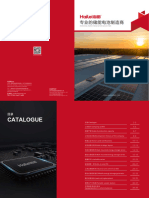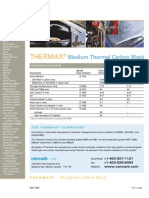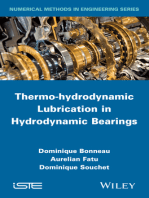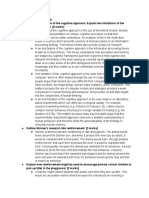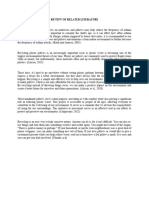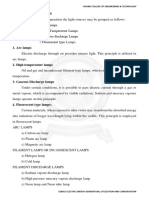CB - n990 Epdm Profiles
CB - n990 Epdm Profiles
Uploaded by
Martha GuzmanCopyright:
Available Formats
CB - n990 Epdm Profiles
CB - n990 Epdm Profiles
Uploaded by
Martha GuzmanOriginal Title
Copyright
Available Formats
Share this document
Did you find this document useful?
Is this content inappropriate?
Copyright:
Available Formats
CB - n990 Epdm Profiles
CB - n990 Epdm Profiles
Uploaded by
Martha GuzmanCopyright:
Available Formats
EPDM Profiles
039 February 2008
THERMAX MEDIUM THERMAL BLACK N990 FOR EPDM PROFILES Thermax medium thermal carbon black N990 is manufactured by the thermal decomposition of natural gas in the absence of oxygen. The thermal process provides a unique carbon black characterized by a large particle size and low structure. Thermax is widely used in applications that require excellent dispersion, superior heat, oil and chemical resistance and outstanding dynamic properties. The large particle size (low surface area) and low structure allow for low compression set, high rebound and low viscosity, maintaining the inherent elastomeric properties of the rubber compound. As a non-reinforcing black, thermal black is often blended with furnace carbon blacks with the latter providing reinforcement especially in non-crystallizing polymers such as EPDM, SBR and NBR. It is well known that high filler loading improves EPDM extruded goods. The benefits include smoother surfaces with a desirable matte finish, sharper edges, better dimensional stability and improved green strength. However, furnace black loading potential is limited as undesirable effects such as difficult processing, heat build-up and scorch, as well as increased compression set, hardness and modulus quickly appear with increasing amounts of furnace black in the compound. The following study, conducted on behalf of Cancarb Limited at the Indian Rubber Manufacturers Research Association, Thane, India, demonstrates that the extrusion benefits of high filler loading can be achieved while maintaining processing and vulcanizate properties through the partial replacement of furnace black with Thermax. In addition, users of Thermax can expect class A surface finish derived from excellent dispersibility and exceptionally low grit content. Experimental In extrusions, the largest application for EPDM rubber, a blend of two furnace blacks with different particle size and structure is typically used to balance processing behaviour and vulcanizate properties. The current study examines compounds at three Shore A hardness levels, specifically 50, 60 and 70. In each case, a compound based on a blend of N550 and N774 is used as the control. The experimental compounds replace all of the N774 in the control with Thermax N990 on the basis of 2 parts of N990 for each part of N774 with the objective of achieving equal hardness.
Compound Recipes Hardness 50 SH A1 EPDM Keltan 512 N550 N774 Thermax N990 Paraffinic Oil ZnO Stearic Acid ZDBC TMTD MBT Sulphur Compound Properties Compound Compound viscosity ML (1+4)@100c (MU) Mooney Scorch t5 @125c (min.) A1 14.5 13.33 A2 15 11 B1 19 11.33 B2 18 9.26 C1 29 7.48 C2 30 8.11 100 60 40 90 5 1 2 0.5 0.5 1.2 A2 100 60 80 90 5 1 2 0.5 0.5 1.2 Hardness 60 SH B1 100 80 50 90 5 1 2 0.5 0.5 1.2 B2 100 80 100 90 5 1 2 0.5 0.5 1.2 Hardness 70 SH C1 100 120 50 90 5 1 2 0.5 0.5 1.2 C2 100 120 100 90 5 1 2 0.5 0.5 1.2
Rheometric Properties @ 160c ML(lbf.inch) MH(lbf.inch) TS2(minutes) T90(minutes) 2.51 35.32 3.15 22.91 2.6 35 2.8 18 2.43 37.18 2.73 20.56 2.62 38.94 2.4 23.18 3.76 47.62 2.27 20.73 3.71 41.79 2.44 19.91
Vulcanizate Properties Compound Hardness On Button (Shore A) 300% Modulus (MPa) Tensile Strength (MPa) Elongation at Break (%) Tear Strength (kN/m) Compression Set (%) ASTM D 395 Method B (@100C/22hrs/25%) Heat Aging Properties Change in Properties after being aged in air @ 100c/ 168 hrs. Compound Hardness change , points Tensile Strength, Change % Elongation at Break, Change % Discussion For all compound pairs, Mooney viscosity, Mooney scorch time and cure time were maintained at similar levels despite total carbon black loading in the Thermax compounds being higher by 40 phr in the case of the 50 hardness recipe and by 50 phr in the 60 and 70 hardness compounds. The vulcanizate properties were also largely unaffected by the carbon black loading increases. A relatively modest increase in compression set is seen due to the increase in total carbon black loading. However, Thermax N990 is known to have the least negative effect on compression set when compared with other blacks at equal loading. As expected, the heat aging results were generally comparable across all compounds. EPDM Rubbers from Metallocene Technology EPDM rubbers produced by Metallocene catalyst technology have higher molecular weights compared to EPDM rubbers produced from solution and suspension polymerization technology. They therefore have superior mechanical properties. However, they are also somewhat more difficult to process. Blending of Thermax N990 in partial replacement of furnace black becomes even more relevant and significant for Metallocene catalyst based EPDM rubbers (see also Technical Bulletin 036 of January 2003). A1 +8 +5.2 -39.5 A2 +9 +4.5 -44 B1 +9 +5.2 -47.3 B2 +10 +3.3 -39 C1 +9 +10.7 -31.7 C2 +10 +4.9 -37.5 A1 49 6.2 8.4 405 22.6 16 A2 50 6.5 8.8 415 22.6 19 B1 58 7.8 9.4 370 25.9 17 B2 58 8.3 8.9 320 24.5 23 C1 69 -NA-8.2 205 24.9 21 C2 68 -NA-8.0 240 22.8 24
You might also like
- 深圳市海雷新能源产品目录 高清Document20 pages深圳市海雷新能源产品目录 高清iveslizhiranNo ratings yet
- Manage Your Time Master Your Life Workbook Sample PDFDocument8 pagesManage Your Time Master Your Life Workbook Sample PDFFiera Chuera100% (4)
- 029 Butyl Rubber CompoundsDocument6 pages029 Butyl Rubber Compoundsrossifam777100% (1)
- Metco 443NS 10-130 PDFDocument14 pagesMetco 443NS 10-130 PDFRohan PatelNo ratings yet
- Comparation of N990 Vs N550 in EPDM CompoundsDocument7 pagesComparation of N990 Vs N550 in EPDM CompoundsMartha GuzmanNo ratings yet
- CB - N990 Dynamic Properties in EPDM and NRDocument5 pagesCB - N990 Dynamic Properties in EPDM and NRMartha GuzmanNo ratings yet
- The in BladdersDocument7 pagesThe in BladdersvijaysatawNo ratings yet
- Technical Bulletin: Chloroprene RubberDocument5 pagesTechnical Bulletin: Chloroprene RubberPrashantha NandavarNo ratings yet
- Thermax N990 Thermal Carbon Black in Nitrile Rubber CompoundsDocument11 pagesThermax N990 Thermal Carbon Black in Nitrile Rubber CompoundsHuỳnh TGNo ratings yet
- Certain Types of Carbon Black Used in TiresDocument2 pagesCertain Types of Carbon Black Used in TiresPLASTIC LAB CBDNo ratings yet
- Engineering Guide: Elastomer SelectionDocument1 pageEngineering Guide: Elastomer SelectionKevin JohnsonNo ratings yet
- Recycle EPDMDocument11 pagesRecycle EPDMmrNo ratings yet
- Ijmet 10 01 013Document9 pagesIjmet 10 01 013IAEME PUBLICATIONNo ratings yet
- 14 - Chapter 5 PDFDocument9 pages14 - Chapter 5 PDFFREDY CORREANo ratings yet
- DSMTS-0033.2 ZrTiY OxideDocument3 pagesDSMTS-0033.2 ZrTiY OxideAndrei MazurcheviciNo ratings yet
- Urea Resistant Epdm Gaskets and HosesDocument22 pagesUrea Resistant Epdm Gaskets and Hosesamh.fpdNo ratings yet
- Refractory For EAF-GuideDocument4 pagesRefractory For EAF-GuideJayasimha TammineniNo ratings yet
- An 10 001 Thermal Paste Application ENGDocument6 pagesAn 10 001 Thermal Paste Application ENGEuge VillarNo ratings yet
- Brochure TIMREX Graphites For Carbon Brushes and Carbon PartsDocument12 pagesBrochure TIMREX Graphites For Carbon Brushes and Carbon PartsvarundodhiaNo ratings yet
- Fep HandbookDocument28 pagesFep HandbookzakariiNo ratings yet
- Tribo-Evaluation of Aluminium Based Metal Matrix Composites Used For Automobile Brake Pad ApplicationsDocument6 pagesTribo-Evaluation of Aluminium Based Metal Matrix Composites Used For Automobile Brake Pad ApplicationsSEP-PublisherNo ratings yet
- DMC - Prasentation1Document8 pagesDMC - Prasentation1Selva BabuNo ratings yet
- Epdm IirDocument7 pagesEpdm IirQuangHưngPNo ratings yet
- CBN Blade Tip AbradableDocument8 pagesCBN Blade Tip Abradablebehtam2407No ratings yet
- Effect of Sulphur On CRMBDocument9 pagesEffect of Sulphur On CRMBdhanesh kumarNo ratings yet
- Óleo Lubrificante MOLYKOTE 1000Document1 pageÓleo Lubrificante MOLYKOTE 1000leandro_hwashinNo ratings yet
- Shell Turbo T32: Performance, Features & Benefits Main ApplicationsDocument3 pagesShell Turbo T32: Performance, Features & Benefits Main ApplicationsPandu Satrio100% (1)
- Gasket Joint SheetDocument5 pagesGasket Joint SheetksathishgreenNo ratings yet
- Practical Guide To HNBR Chapter 2Document8 pagesPractical Guide To HNBR Chapter 2Azizol WahabNo ratings yet
- MPTMSDocument8 pagesMPTMSShahzad ShahNo ratings yet
- Material Product Data Sheet Zirconia - Polymer Ceramic Abradable PowdersDocument4 pagesMaterial Product Data Sheet Zirconia - Polymer Ceramic Abradable PowderskerbaubiruNo ratings yet
- LUBMARINE ATLANTA MARINE D en 2003-09Document2 pagesLUBMARINE ATLANTA MARINE D en 2003-09Alain PoncinNo ratings yet
- Eng-Improved Erosion - Lubna AlaaDocument12 pagesEng-Improved Erosion - Lubna AlaaImpact JournalsNo ratings yet
- Metallic Coagents For Rubber To Metal AdhesionDocument7 pagesMetallic Coagents For Rubber To Metal AdhesionHuỳnh TGNo ratings yet
- Abrasion of High Temperature Conveyor BeltDocument12 pagesAbrasion of High Temperature Conveyor Beltluong van toiNo ratings yet
- Experimental Analysis of Hard Coating On Spur Gear: ISSN (PRINT) :2394-6202, (ONLINE) :2394-6210, VOLUME-3, ISSUE-5,2017 1Document6 pagesExperimental Analysis of Hard Coating On Spur Gear: ISSN (PRINT) :2394-6202, (ONLINE) :2394-6210, VOLUME-3, ISSUE-5,2017 1Jamsheer IbrahimNo ratings yet
- ANDPr 9 Urd 9 If PTK 15 Vu 5 Q 9 LB QK 70 I PAh MC5 S TK PPDocument1 pageANDPr 9 Urd 9 If PTK 15 Vu 5 Q 9 LB QK 70 I PAh MC5 S TK PPAshraf AbouleishNo ratings yet
- MT Carbon Cancarb N990Document1 pageMT Carbon Cancarb N990Gaurav JainNo ratings yet
- Rubber CuringDocument132 pagesRubber CuringDuc Nguyen100% (3)
- EpdmDocument20 pagesEpdmsharmapragya0121No ratings yet
- Metco - Thermal Spray Powders (Nickel Chromium Alloy Boron Nitride)Document3 pagesMetco - Thermal Spray Powders (Nickel Chromium Alloy Boron Nitride)Hamed AhadiNo ratings yet
- Gpcdoc Local Tds Iraq Shell Turbo T 32 (Ar-Iq) TdsDocument3 pagesGpcdoc Local Tds Iraq Shell Turbo T 32 (Ar-Iq) Tds100impian100% (1)
- Materials Selection Guide AluminiaDocument3 pagesMaterials Selection Guide AluminiaHardik AcharyaNo ratings yet
- Zirconia Coating DSMTS-0038.1 - CeZrODocument3 pagesZirconia Coating DSMTS-0038.1 - CeZrObotan_mihaiNo ratings yet
- GEAR MESP SS 150 T SUNRAYDocument1 pageGEAR MESP SS 150 T SUNRAYmanjushah610No ratings yet
- Schaeffer # 229Document3 pagesSchaeffer # 229Ingeniero aicNo ratings yet
- Barniz DolpsDocument3 pagesBarniz DolpsCordero FranciscoNo ratings yet
- Firestone Rubbergard EpdmDocument12 pagesFirestone Rubbergard Epdmzafranbatagrame7No ratings yet
- Effect of Heat Treatment and Case Carburizing High-Density PM SteelsDocument11 pagesEffect of Heat Treatment and Case Carburizing High-Density PM SteelsrobinajNo ratings yet
- New Seals Solve Vibration Problem: Sulzer Turbo ServicesDocument3 pagesNew Seals Solve Vibration Problem: Sulzer Turbo ServicesHamid MojiryNo ratings yet
- TREMproof 6100 (2)Document12 pagesTREMproof 6100 (2)bdoherty1608No ratings yet
- Asphalt Rubber Open Graded Friction Course: Jeffrey R. SmithDocument15 pagesAsphalt Rubber Open Graded Friction Course: Jeffrey R. SmithYousef AlipourNo ratings yet
- Mechster 5310 (N) - 300: Commitment To Quality and ConsistencyDocument1 pageMechster 5310 (N) - 300: Commitment To Quality and ConsistencyreinpolyNo ratings yet
- 58 310M 311Document1 page58 310M 311John Melanathy IINo ratings yet
- Shell Turbo Oil T 32 TDSDocument2 pagesShell Turbo Oil T 32 TDSBahim Bahiman100% (1)
- Ceran-Xm-220 TDS v171128Document2 pagesCeran-Xm-220 TDS v171128phucdc095041No ratings yet
- Viscoelastic Damping PolymersDocument8 pagesViscoelastic Damping PolymerszafbspamNo ratings yet
- Roll-to-Roll Manufacturing: Process Elements and Recent AdvancesFrom EverandRoll-to-Roll Manufacturing: Process Elements and Recent AdvancesJehuda GreenerNo ratings yet
- Proceedings of the 8th International Symposium on Superalloy 718 and DerivativesFrom EverandProceedings of the 8th International Symposium on Superalloy 718 and DerivativesNo ratings yet
- Kep EPDM SeriesDocument4 pagesKep EPDM SeriesMartha GuzmanNo ratings yet
- Implementing SPC in The Materials Control LabDocument6 pagesImplementing SPC in The Materials Control LabMartha GuzmanNo ratings yet
- Filler-Filler and Filler-Elastomer InteractionsDocument12 pagesFiller-Filler and Filler-Elastomer Interactions14021292No ratings yet
- PPAPDocument11 pagesPPAPvikasavhadNo ratings yet
- CB - n990 Epdm ProfilesDocument3 pagesCB - n990 Epdm ProfilesMartha GuzmanNo ratings yet
- Formulation Epdm 50 MlouldingDocument1 pageFormulation Epdm 50 MlouldingMartha GuzmanNo ratings yet
- Lecture 3 EMA 202Document68 pagesLecture 3 EMA 202Evans AwuahNo ratings yet
- EasyGate SPT-G Technical SpecificationDocument2 pagesEasyGate SPT-G Technical SpecificationJose FernandesNo ratings yet
- Chapter I ErrorDocument10 pagesChapter I ErrorMelakuNo ratings yet
- Graphics MODULE-1 NOTES ReferDocument30 pagesGraphics MODULE-1 NOTES ReferAleena JubyNo ratings yet
- Listening 1Document3 pagesListening 1An Vũ ĐồngNo ratings yet
- PE and Health Reviewer 1Document16 pagesPE and Health Reviewer 1MackielNo ratings yet
- Paper 2 WorkthroughDocument10 pagesPaper 2 WorkthroughKesithan AnandarashNo ratings yet
- Reading and Writing Module 1Document29 pagesReading and Writing Module 1Billie Joys OdoganNo ratings yet
- Clip ScoreDocument15 pagesClip ScoreNguyễn ThànhNo ratings yet
- Discovery and Exploration: Home Based Learning Materials For Mathematics Grade 4Document3 pagesDiscovery and Exploration: Home Based Learning Materials For Mathematics Grade 4Lyn Evert Dela Peña100% (1)
- Answer Key: Further 04: PhoneticsDocument5 pagesAnswer Key: Further 04: PhoneticsAbby NguyễnNo ratings yet
- Review of Related Literature Sa Capstone yDocument1 pageReview of Related Literature Sa Capstone ybuenafefloresNo ratings yet
- Instant Access to A First Course in Control System Design 2nd Edition Kamran Iqbal ebook Full ChaptersDocument40 pagesInstant Access to A First Course in Control System Design 2nd Edition Kamran Iqbal ebook Full ChaptersduhmekohenpmNo ratings yet
- DLL Science 7 JulyDocument10 pagesDLL Science 7 JulyMark Kiven Martinez100% (1)
- Formal Biology Lab ReportsDocument2 pagesFormal Biology Lab ReportsSweetie AndersonNo ratings yet
- 7 QC Tools: Training Module OnDocument38 pages7 QC Tools: Training Module OnSomnath BanerjeeNo ratings yet
- Architecture SpacesDocument15 pagesArchitecture SpacesJagmeet Singh MangatNo ratings yet
- DSP NewsletterDocument3 pagesDSP NewsletterAnoojNo ratings yet
- Communicate 3Document91 pagesCommunicate 3Choi Seo RinNo ratings yet
- 5318.9100 AnemometerDocument8 pages5318.9100 AnemometerLaurentiu VieruNo ratings yet
- Material ConstructionDocument11 pagesMaterial Construction23004265No ratings yet
- 481T CN B1 803 A1 (Agile Scrum Pre Course1)Document190 pages481T CN B1 803 A1 (Agile Scrum Pre Course1)Khaled GamalNo ratings yet
- Worksheet-Journey To The End of The Earth-Xii Anjali DwivediDocument2 pagesWorksheet-Journey To The End of The Earth-Xii Anjali DwivediRudra Mishra100% (3)
- 1ER DEVOIR DU 2ÈME TRIMESTRE ANGLAIS 1ÈRE ABCD 2021-2022 CPEG SAINT JUSTINDocument3 pages1ER DEVOIR DU 2ÈME TRIMESTRE ANGLAIS 1ÈRE ABCD 2021-2022 CPEG SAINT JUSTINTon MecNo ratings yet
- Advanced Construction MaterialsDocument37 pagesAdvanced Construction MaterialsZara AliNo ratings yet
- Toilet Paper Solar System PDFDocument3 pagesToilet Paper Solar System PDFShellz RahmanNo ratings yet
- Kissinger ReportDocument3 pagesKissinger Reportlazaro netoNo ratings yet
- Rohini 91166894261Document8 pagesRohini 91166894261Dharmendra YadavNo ratings yet
